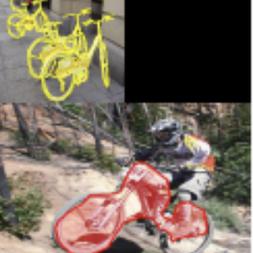Search Results for author: Chuyang Ye
Found 17 papers, 5 papers with code
Advancing Brain Tumor Inpainting with Generative Models
no code implementations • 2 Feb 2024 • Ruizhi Zhu, Xinru Zhang, Haowen Pang, Chundan Xu, Chuyang Ye
Synthesizing healthy brain scans from diseased brain scans offers a potential solution to address the limitations of general-purpose algorithms, such as tissue segmentation and brain extraction algorithms, which may not effectively handle diseased images.
Better Generalization of White Matter Tract Segmentation to Arbitrary Datasets with Scaled Residual Bootstrap
no code implementations • 25 Sep 2023 • Wan Liu, Chuyang Ye
Since both of them lead to different signal-to-noise ratios (SNRs) between the training and test data, we propose to augment the training scans by adjusting the noise magnitude and develop an adapted residual bootstrap strategy for the augmentation.
Unsupervised Brain Tumor Segmentation with Image-based Prompts
no code implementations • 4 Apr 2023 • Xinru Zhang, Ni Ou, Chenghao Liu, Zhizheng Zhuo, Yaou Liu, Chuyang Ye
Specifically, instead of directly training a model for brain tumor segmentation with a large amount of annotated data, we seek to train a model that can answer the question: is a voxel in the input image associated with tumor-like hyper-/hypo-intensity?
Fiber Tract Shape Measures Inform Prediction of Non-Imaging Phenotypes
no code implementations • 16 Mar 2023 • Wan Liu, Yuqian Chen, Chuyang Ye, Nikos Makris, Yogesh Rathi, Weidong Cai, Fan Zhang, Lauren J. O'Donnell
In this paper, we investigate the potential of fiber tract shape features for predicting non-imaging phenotypes, both individually and in combination with traditional features.
One-Shot Segmentation of Novel White Matter Tracts via Extensive Data Augmentation
1 code implementation • 13 Mar 2023 • Wan Liu, Qi Lu, Zhizheng Zhuo, Yaou Liu, Chuyang Ye
However, accurate segmentation of novel WM tracts can still be challenging in the one-shot setting, where only one scan is annotated for the novel WM tracts.
Positive-unlabeled learning for binary and multi-class cell detection in histopathology images with incomplete annotations
1 code implementation • 16 Feb 2023 • Zipei Zhao, Fengqian Pang, Yaou Liu, Zhiwen Liu, Chuyang Ye
Typically, to train CNN-based cell detection models, every positive instance in the training images needs to be annotated, and instances that are not labeled as positive are considered negative samples.
A microstructure estimation Transformer inspired by sparse representation for diffusion MRI
1 code implementation • 13 May 2022 • Tianshu Zheng, Cong Sun, Weihao Zheng, Wen Shi, Haotian Li, Yi Sun, Yi Zhang, Guangbin Wang, Chuyang Ye, Dan Wu
Thus, the METSC is composed with three stages, an embedding stage, a sparse representation stage, and a mapping stage.
CarveMix: A Simple Data Augmentation Method for Brain Lesion Segmentation
1 code implementation • 16 Aug 2021 • Xinru Zhang, Chenghao Liu, Ni Ou, Xiangzhu Zeng, Xiaoliang Xiong, Yizhou Yu, Zhiwen Liu, Chuyang Ye
Data augmentation is a widely used strategy that improves the training of CNNs, and the design of the augmentation method for brain lesion segmentation is still an open problem.
Positive-unlabeled Learning for Cell Detection in Histopathology Images with Incomplete Annotations
no code implementations • 30 Jun 2021 • Zipei Zhao, Fengqian Pang, Zhiwen Liu, Chuyang Ye
Usually, incomplete annotations can be achieved, where positive labeling results are carefully examined to ensure their reliability but there can be other positive instances, i. e., cells of interest, that are not included in the annotations.
Knowledge Transfer for Few-shot Segmentation of Novel White Matter Tracts
no code implementations • 30 May 2021 • Qi Lu, Chuyang Ye
The expensive manual delineation can be a particular disadvantage when novel WM tracts, i. e., tracts that have not been included in existing manual delineations, are to be analyzed.
Segmentation-based Method combined with Dynamic Programming for Brain Midline Delineation
no code implementations • 27 Feb 2020 • Shen Wang, Kongming Liang, Chengwei Pan, Chuyang Ye, Xiuli Li, Feng Liu, Yizhou Yu, Yizhou Wang
The midline related pathological image features are crucial for evaluating the severity of brain compression caused by stroke or traumatic brain injury (TBI).
Knowledge Transfer between Datasets for Learning-based Tissue Microstructure Estimation
no code implementations • 24 Oct 2019 • Yu Qin, Yuxing Li, Zhiwen Liu, Chuyang Ye
Then, the interpolated signals are used together with the high-quality tissue microstructure computed from the source dataset to train deep networks that perform tissue microstructure estimation for the target dataset.
Semi-Supervised Brain Lesion Segmentation with an Adapted Mean Teacher Model
1 code implementation • 4 Mar 2019 • Wenhui Cui, Yanlin Liu, Yuxing Li, Menghao Guo, Yiming Li, Xiuli Li, Tianle Wang, Xiangzhu Zeng, Chuyang Ye
Since unannotated data is generally abundant, it is desirable to use unannotated data to improve the segmentation performance for CNNs when limited annotated data is available.
Learning-based Ensemble Average Propagator Estimation
no code implementations • 20 Jun 2017 • Chuyang Ye
The diffusion profile can be described by the ensemble average propagator (EAP), which is inferred from observed diffusion signals.
Fiber Orientation Estimation Guided by a Deep Network
no code implementations • 19 May 2017 • Chuyang Ye, Jerry L. Prince
In this work we explore the use of a deep network for FO estimation in a dictionary-based framework and propose an algorithm named Fiber Orientation Reconstruction guided by a Deep Network (FORDN).
Estimation of Tissue Microstructure Using a Deep Network Inspired by a Sparse Reconstruction Framework
no code implementations • 5 Apr 2017 • Chuyang Ye
In this work, we propose a deep network based approach to the NODDI microstructure estimation, which is named Microstructure Estimation using a Deep Network (MEDN).
Estimation of Fiber Orientations Using Neighborhood Information
no code implementations • 16 Jan 2016 • Chuyang Ye, Jiachen Zhuo, Rao P. Gullapalli, Jerry L. Prince
Data from diffusion magnetic resonance imaging (dMRI) can be used to reconstruct fiber tracts, for example, in muscle and white matter.






